|
|
#4---440 Stage1 Dyno Test 07/14/2002
558.5 HP & 574.2 ft/lb | 12/14/2021
David Hughes |
The following series of tests were performed on our Stage I, 501HP engine, part number 440LONG-S1. This is our basic Stage I engine, (cast iron heads, hydraulic camshaft, pump gas) with a camshaft 1 size larger, HE3844BL, in place of the standard HE3038BL. The dyno test has some extra manifold tests added for research and development. This is one of our most popular long block engine combinations. This engine was built in our shop and dyno tested by our personnel.
Dyno Test 1:
This test was conducted with a deep port matched and plenum rework P/N i326, EDE 5091 intake. This manifold should be used when hood clearance is a problem.
Results: 538HP @ 5400RPM, 548 ft-lbs torque @ 4600RPM.
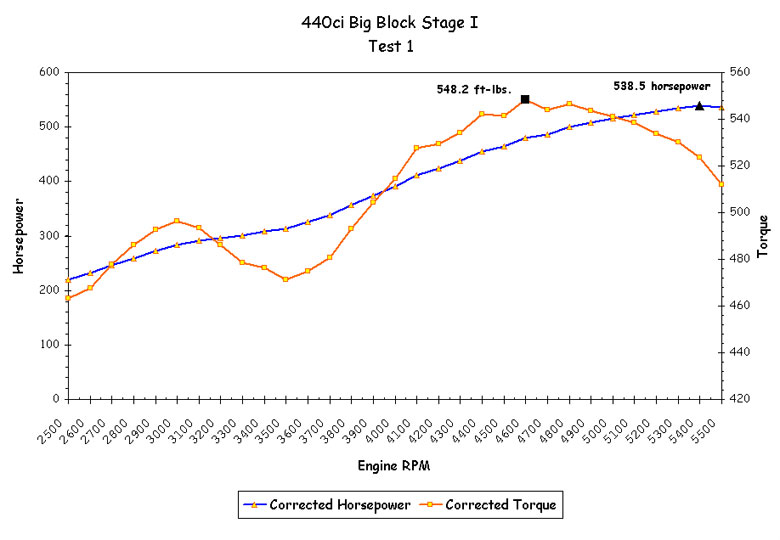
Click here for larger image
|
Dyno Test 2:
This combination uses an EDE 7193 ; our deep port-match and plenum rework P/N i326.
Results: 542.7HP @ 5900RPM, 561.3 ft-lbs torque @ 4400RPM .
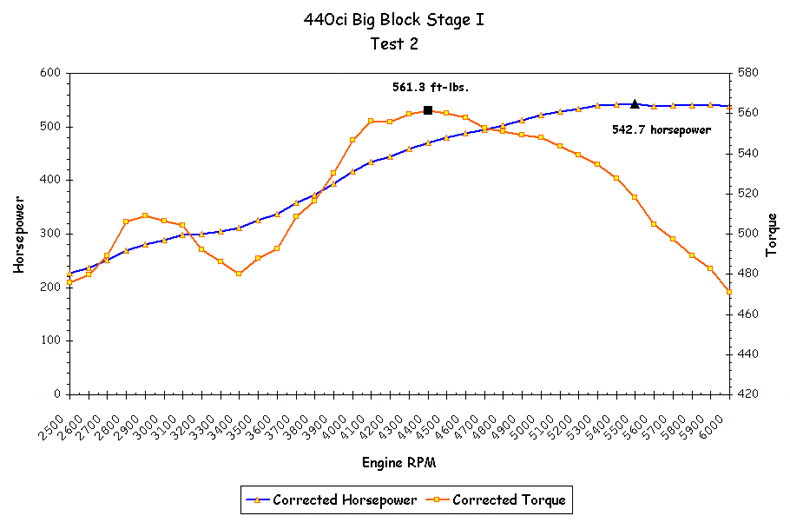 Click here for larger image
Click here for larger image
|
Test 1 and 2 notes:
This test shows this combination makes a very strong street/strip engine. For street use, please note that our HE3844BL cam has already produced 463 ft-lbs torque by 2500RPM with the Torker II intake and 8 ft-lbs more with the RPM intake. Get friendly with your local Goodyear dealer; you are going to be seeing him a lot. In our cam listings we claim that the sweet spot starts at 2400RPM for the HE 3844 BL cam, obviously it is well under that by then and most likely starts just above idle. This is why David Connelly is able to tow a trailer when using this cam. The torque is over 500 ft-lbs torque form 3700RPM to 5600RPM with a very flat torque curve. The horsepower is over 500 from as low as 4400RPM to over 7000RPM (estimated)
|
Dyno Test 3:
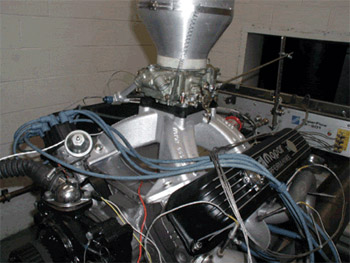 Edelbrock loaned us an early version of their new Victor 440 intake. We deep port matched and did some plenum work only on it.
Results: 558.7HP @ 5900RPM and 564.7 ft-lbs torque @ 4700RPM.
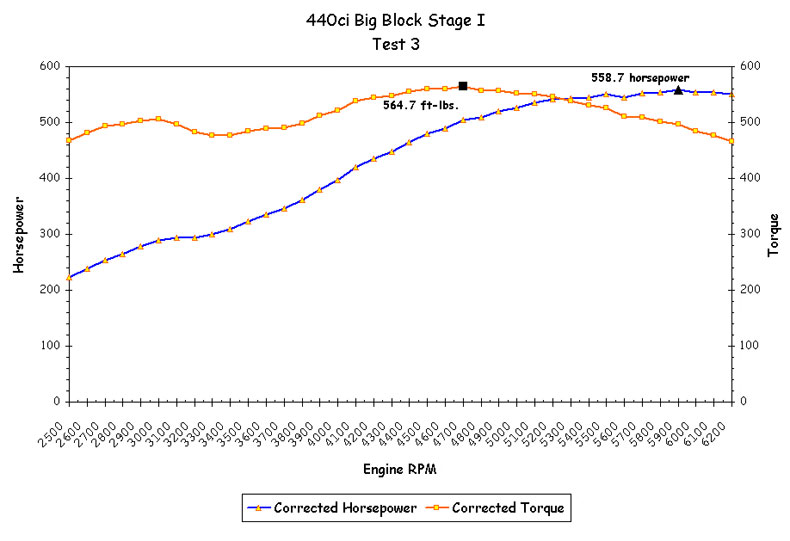 Click here for larger image
Click here for larger image |
Test 3 Notes:
Notice that around 3300RPM it was only down about 5 HP and 8 ft lbs torque. It quickly recovers at 3500RPM and was stronger by 15 HP and 11 ft lbs torque. If we had tried our next size larger cam HE4449BL the Victor 440 would have been stronger all the way up (but then it wouldn't have been a Stage I engine). Note that the Victor was much stronger, about 23HP and 23ft-lbs torque at 6200RPM, indicating that it's true place is with engines built with more displacement and/or more RPM.
|
Dyno Test 4:
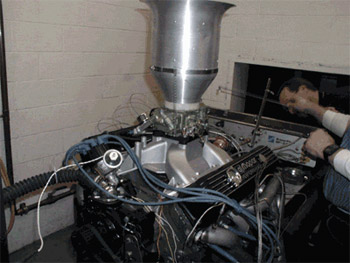 We used our MODIFIED version of the Mopar Performance M-1 intake, with the i350 modification. The manifold is deep port matched and its plenum area is welded up and reconfigured for a square bore carburetor.
Results: 558.5HP @ 5800RPM and 574.5 ft-lbs torque @ 4700RPM
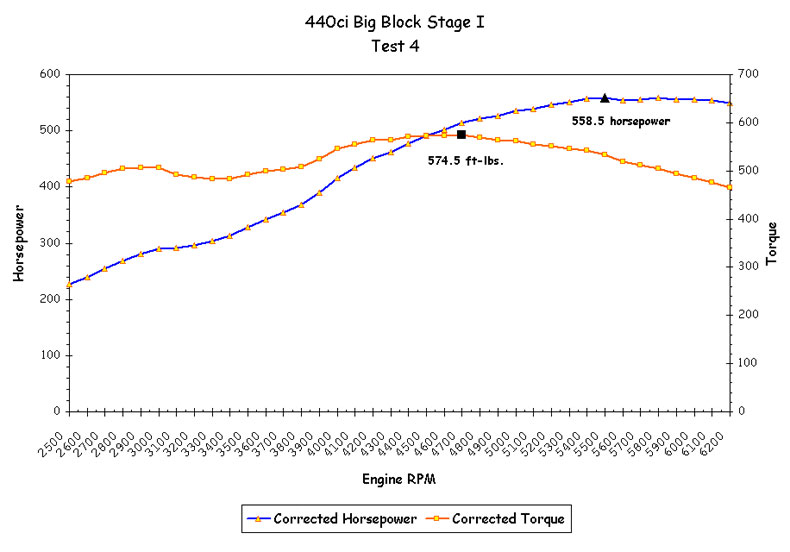 Click here for larger image
Click here for larger image
|
Test 4 Notes:
Remember, you saw it here first, and we are going to say it here first. Actually it has already been said but not for Mopars yet. A modern, well developed, single plane intake (this is the reason you haven't heard it about Mopars yet, there aren't any unless you build your own) will perform just as well if not better than a good dual plane, over a wider RPM range, in most situations. Here we have a high rise, single plane, intake that has more power from 2500RPM than the dual plane RPM intake. This manifold should not have shown up this well, especially at 2500RPM. Does our modified M-1 think it is an RV intake too?
Well to start off with we have a single plane intake that walks nearly side-by-side in torque with the Performer RPM intake up to 3600RPM then pulls away at 4600RPM's. It starts out with more torque than either the Performer RPM or the Victor 440 at 2500RPM and better than the Performer RPM (except at 3300RPM and it is only down there about 7 ft-lbs there). It ends up over 19 ft lbs stronger. In the HP column it nearly parallels with the Performer RPM until 3100RPM then it's gone with a peak of nearly 11 more HP. Also notice the torque at that point, 5800RPM, it is still 18 ft-lbs more. At 5800RPM this engine is really pulling hard. The torque advantages over the Victor 440 in the lower RPM ranges is amazing.
Conclusion and What the tests Prove:
The Stage I combination is a very well matched set of components. The Stage I HP porting will make 550 HP in the right engine and the HE3844BL will make power up into the 550HP+ range with enough head and intake air flow. The new 440 Victor intake is designed more for combinations that will produce power levels closer to 600 HP and above. However, it didn't do too bad in the 550HP range. Notice how the modified M-1 produced the highest torque throughout the basic "Street Spot", but up at 6200RPM the Victor was 13 ft-lbs more. The Victor wants cams and heads that work at higher RPMs.
The surprise was our modified M-1 intake. It made the most torque, 574 ft-lbs. That is 27 lbs more at its peak over the Performer RPM intake at the same RPM level. This is the best manifold choice for an engine in the 535HP to 585HP range. This was our first dyno test of this manifold on a Big Block, but we have seen it pick up 25HP on Small Block dyno tests. It is generally worth 1.5 to 2 tenths on a mid 11's Big Block car over any other intake we have track tested. This engine combination in its designed form, as a Stage I engine with an HE3038BL cam and the re-worked Performer RPM intake manifold, is probably a lot closer to 525HP than it is rated 501HP. More power will have to come from more camshaft, bigger heads, intake, and at some expense of streetability. This engine with our modified M-1 intake should easily take a 3600lbs car and driver into the mid 11's, and be very streetable. With the smaller HE3038BL cam that was designed for the Stage I, the Performer RPM intake might be the best choice.
|
|
|
| | Home | Phone: 309-745-9558 | Email: information@hughesengines.com |



